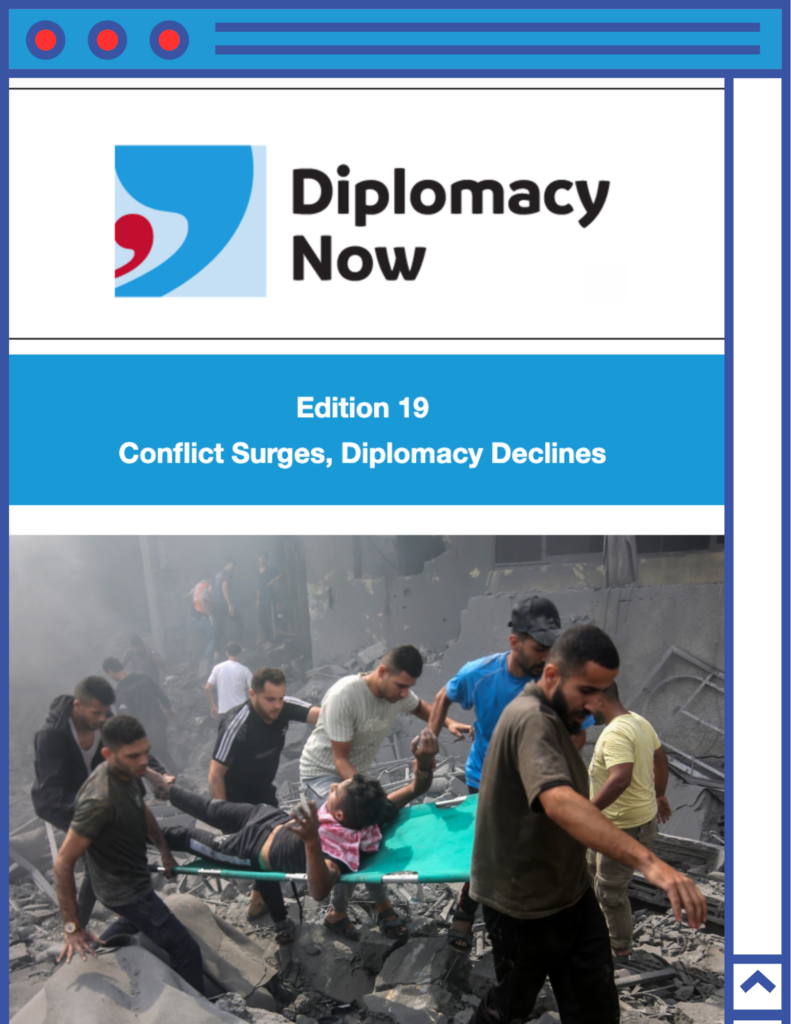In the summer of 2014, while the third Israel-Hamas war was raging, I was invited to a side meeting at a conference I was attending in Europe. The meeting included a handful of Israelis and Palestinians. Also present was a senior US State Department official. “What should we do about the war in Gaza?” he asked. “Three things,” I said in response: “a ceasefire; a humanitarian corridor; and, for heaven’s sake, try to find a long-term solution to Gaza.”
Two weeks later, on August 26, an Egyptian-mediated deal ended the 51-day war and humanitarian aid started to flow into the war-torn enclave. Only the “Gaza question” remained open and unresolved. Nine years later, on the morning of October 7, 2023, Gaza exploded, when Hamas and other Palestinian armed groups launched a surprise attack on Israel’s southern border communities, killing 1,200 people and taking 250 hostages. In response, Israel retaliated by imposing a total closure on the Gaza Strip and launching a massive air, sea and land military campaign that, one year on, resulted in a staggering human toll (over 43,000 killed and 101,000 injured, as of October 29) and laid much of the besieged Strip to waste.
The devastating details of what happened in Gaza since the war started are largely known, covered by various media outlets, and reported by the UN agencies and international NGOs with staff on the ground. Also known are the sheer scale and scope of the dire humanitarian crisis in Gaza; the massive, forced, and repeated internal displacement; the spread of diseases and hunger; the extensive destruction of civilian infrastructure; and the near total breakdown of law and order. Proposed plans for the “day after” drafted by a number of US-based think tanks on the future of the coastal territory are all found on the internet (see, for example, here, here, and here). Other ideas for post-war Gaza outlined by Israel (here and here), the United States, and the United Arab Emirates, are also found there, along with perceptive thoughts by independent scholars pitching their views on the subject (here and here).
Absent from the discussion, however, are critical questions like: what led to this war in Gaza? what went wrong on the policy front? and, more importantly, whether this man-made tragedy could have been avoided. Answers to these questions are glaringly lacking in the rush to produce post-war plans. Yet, without understanding Gaza, these plans for the day after may very well end up leading to the mismanagement of the beleaguered Palestinian enclave— mismanagement that led to its ongoing destruction in the first place. If this were to happen, the price next time around would be significantly higher, since it will involve dealing with a highly traumatized young population struggling to survive in a war-ravaged place that is becoming increasingly uninhabitable.
The Gaza Question
Gaza has a number of salient features that sets it apart from the rest of the occupied Palestinian territories. Among them is the high population density, where an estimated (pre-war) 2.3 million people are squeezed in an area of 365 square kilometers (141 square miles); the large number of UN-registered refugees accounting for 70 percent of Gazans, the majority of them live in eight overcrowded and squalid refugee camps; a burgeoning young population increasing annually by 2.8 percent – among the highest growth rates in the world – with nearly 50 percent under the age of 18; and a fast growing labor force, with new entrants to the job market joining long unemployment lines in a virtually broken and small economy.
High rates of joblessness, especially among youth (60 percent) and women (64 percent), widespread poverty (64 percent), and severe food insecurity (41 percent), have produced extremely dire living conditions, rendering 80 percent of Gaza residents dependent on humanitarian aid for survival. Dilapidated infrastructure, environmental degradation, institutional decay, and chronic shortages in electricity and potable water added further strains. The gravity of Gaza conditions twice led the UN, in 2012 and again in 2015, to warn that, if nothing is done to reverse course, the whole place could become unlivable by the year 2020.
That was Gaza before October 7.
Gaza’s misfortune, however, did not start with Hamas’ armed takeover of the coastal enclave in June 2007— rather, it started four decades earlier, in June 1967, and it has been growing ever since. Whether under the Israeli direct military occupation (1967-1994), or under the Palestinian Authority (PA) rule (1994-2007), or under Hamas control after 2007, a toxic combination of neglect, restrictions, and mismanagement have all contributed to produce a highly untenable and combustible situation that was bound to explode, as it did many times in the past, with the eruption of the first and the second intifadas in 1987 and 2000, and later with the outbreak of three wars between Israel and Hamas in 2008/09, 2012, and 2014; and another limited one in 2021 with the Palestinian Islamic Jihad. Then came the big one: October 7.
Failing Gaza
On the eve of October 7, the picture in Gaza looked very bleak, with the immediate parties to the enclave’s misfortune (Israel, the PA, and Hamas), along with the international community (mainly, the US and the EU), seemingly content with managing Gaza, without exerting serious efforts to bring about a real change to the lives of the 2.3 million people trapped and isolated in the narrow coastal Strip.
Israel, on one hand, found itself in its preferred comfort zone: satisfied with managing Gaza through economic blockade; intermittently conducting military operations against Hamas to undermine its fighting capabilities, while at times easing its severe restrictions to allow Gaza a breathing space, but with no urgency to address the root causes of its predicament. This was an unsustainable containment strategy as October 7 has vividly shown.
The Palestinians, on the other hand, were busy with their never-ending internal bickering, exchanging recriminations for failing to reach a reconciliation pact to end their 16-year-long political division, or to agree on a workable modus vivendi arrangement to pull Gaza away from its fast descent into the abyss. And the West, while continuing to provide desperately needed aid— largely through making financial contributions to UNRWA’s annual budget and other UN agencies— to meet Gaza’s basic humanitarian needs, seemed unable or unwilling to play a more assertive political role to help bring an end to Gaza calamity.
With such a collective failure, an explosion was inevitable. And the irony of it all is that while Gaza has often been described as a “ticking time bomb,” little of substance was done to defuse it.
Gaza Lessons
Reflecting on the 56-year history of Gaza under three different governing regimes (Israel’s direct occupation, the PA, and Hamas), one finds that, during each one of them, there was an opportunity for Gaza to grow and have a better future. That potential, however, had tragically been either denied or squandered, leaving in its stead festering misery and anger. Not surprisingly, each one of these three chapters of rule ended with violence. The first intifada ended Israel’s direct military presence in Gaza (except in the 21 Jewish settlements which were later evacuated in the context of disengagement in 2005); the second intifada and Hamas armed takeover of Gaza ended the PA rule there; and the current year-long war, in all likelihood, will end Hamas’ 16-year control over the besieged and now vastly ruined coastal enclave.
Gaza teaches us four hard lessons: (1) leaving Gaza to rot in poverty and hopelessness while Israel grows and prospers is a bad policy. Consider this: a trendy Tel Aviv is only 45 miles north of the Gaza ghetto. This is politically unsustainable; (2) technical solutions sans a conducive political setting are inadequate to address conflict-induced socioeconomic challenges. Alone, these solutions are ineffective and do not constitute an efficient use of time and resources; (3) managing Gaza in silo, outside its wider Israeli-Palestinian context, doesn’t work, and, over time, makes things far worse and more complicated; and (4) what happens in Gaza does not stay in Gaza, and has serious regional reverberations (think Lebanon, Yemen, and Iran).
A post-war plan for a ruined Gaza should benefit from, and be guided by, these painfully-learned lessons. More importantly, any assessment of the effectiveness of any proposed plan for the “day after” should be measured against them. Learning from past mistakes is always wise. Repeating them in today’s apocalyptic conditions in Gaza is a dangerous undertaking and a recipe for an enduring conflict.
A Future for Gaza?
A year into the ruinous war, it is still unclear when the current carnage will end; what kind of Gaza Strip will emerge in its aftermath; and most importantly, who will run the pulverized enclave in the day after. Different scenarios projected different outlooks for post-war Gaza, are all grim, but plausible. Gaza, in one scenario, could be reduced to a squalid supercamp of internally displaced persons, completely dependent on international aid, run by gangs, and with no central government. Another scenario would see Gaza as a rubble-ridden set of tent camps policed by the Israeli military that will be battling Hamas and other armed groups. A third scenario expects that Gaza will continue, for years, to be an utter humanitarian disaster with no effective governance, just a Mad Max patchwork of Hamas, local families, gangs, and aid agencies. The Economist magazine, in a fourth scenario, projects an anarchic and largely lawless Gaza becoming a Mogadishu on the Mediterranean, controlled by warlords, with Israel re-occupying parts of the Strip.
These scenarios portend an open-ended war in Gaza. Preventing such an outcome should be the central goal of any post-war plan designed to run the embattled enclave—the reason why such a plan should be carefully thought out. While proposed plans for the day after are many and varied, none yet has emerged as a credible candidate. Even the three-phase ceasefire plan announced by the US president on May 31, 2024, was conspicuously silent on how or who will administer post-war Gaza.
Designing a day after plan for Gaza is not an easy exercise, however. With so many players actively involved in shaping the war’s outcome; so many vested interests in Gaza’s future; and so many variables dominating the Gaza equation, the stakes are extremely high. And yet, a workable solution must be found in order to respond, effectively and rapidly, to the catastrophic humanitarian situation in Gaza, and, ultimately, position the vastly-wrecked place on the long road to recovery and reconstruction— if that is at all possible. International experience in post-conflict management could provide a useful guide, but Gaza is a special case; a “handle-with-care” case. If bungled, it could spell unforeseen dramatic consequences for many years to come.
Dr. Mohammed Samhouri is a Gaza-born Palestinian economist and academic. He is a former senior economic advisor in the Palestinian Authority and a former senior research and teaching fellow at Brandeis University’s Crown Center for Middle East Studies in Boston. In 2005, he led a team of 40 Palestinian technical experts to prepare Gaza for the day after Israeli disengagement. He is the author of the 2017 UNDP-commissioned report Beyond Survival: Challenges to Economic Recovery and Long-Term Development in the Gaza Strip. This piece is a short, revised and updated version of an essay published by the Middle East Institute in October.




